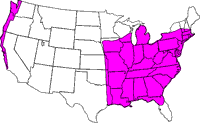 |
| Areas Best For Rhododendron |
The Right Place
Rhododendrons thrive in a location that is sunny in the morning but offers protection from the hot afternoon sun. The dappled shade under a high canopy of tree branches is ideal, offering about 20% to 30% shade. In the South and other areas that are very hot, they do best in more shade. Avoid planting rhododendrons near shallow-rooted trees such as elm, oak or maple, which compete aggressively with them for available soil moisture. Locate rhododendrons where they are protected from cold north winds and winter sun. They require moist, woodsy, well-drained soil with lots of organic matter mixed into it. It should be on the acid side (pH 5.5 to 6.5). To assure this, add some adding peat moss, garden sulfur or used coffee grounds to it periodically.
Planting Nursery Stock
Because they have shallow roots, container grown shrubs can be planted almost anytime during the growing season. Plant field grown rhododendrons whose rootball is wrapped in burlap in spring or after new growth has hardened a bit by late summer. Plant them in the spring up until early April when their growth begins. Otherwise, wait until later in the season--August or September--after they have bloomed. Remove the shrub from its container or wrappings. Pull apart or cut any roots that are densely matted, spreading them gently. Remove as much burlap and string as possible without losing the soil around the rootball. If it is natural burlap, what remains will rot in the hole eventually.
Dig a saucer-shaped planting hole wide enough to accommodate the rootball of the shrub. Score its sloping sides with a trowel or shovel to loosen the soil a bit, but do not put any loose soil at the bottom of the hole. Place the shrub in the empty hole, making certain that the top of the rootball is at, or slightly above ground level. Fill the hole with just plain soil to the level of the surrounding ground and water thoroughly to provide good soil-to-root contact. In the South where the soil is clay, plant rhododendrons virtually above ground. Pile soil rich in organic matter around the rootball or raise the soil level of the entire planting area with specially conditioned soil that holds moisture, but drains well. Mulch them well.
Do not fertilize until the shrub becomes established in six months or a year. Spread organic mulch such as chopped leaves or wood chips on the soil over the roots to protect them and retain soil moisture. Reserve 5 to 8 feet of open space around individual shrubs to allow for their mature spread. Grouped young rhododendrons only 5 feet apart for immediate effect, and then transplant every other one in a few years when they begin to crowd one another.
Amendments In Planting or Transplanting
There are a number of products at the garden center that will help your newly planted or transplanted plants deal better with the stress inherent in the planting process. All healthy plants have beneficial fungi, called mycorrhizal fungi, living on their roots. You can buy these valuable additions to your plant’s ecosystem. See the file describing Using Micorrhizae When Planting.
In addition, there are a number of products such as seaweed, compost tea, and beneficial soil microbes that when added to the planting process will help your newly established plants get going faster. See the file New Technology In Plant Growth Activators
For more information see the file on Planting Shrubs. For planting tools see Hand Tools For Digging and Planting in Yardener’s Tool Shed.

